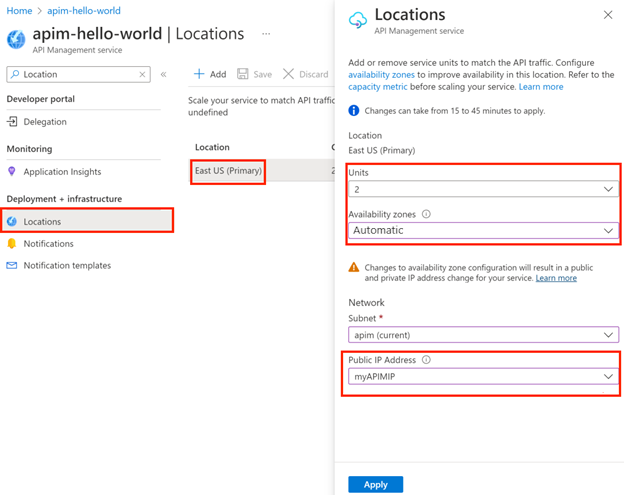Note
Access to this page requires authorization. You can try signing in or changing directories.
Access to this page requires authorization. You can try changing directories.
APPLIES TO: Premium
This how-to guide describes how to enable and configure availability zones on an Azure API Management instance.
For more detailed information about reliability features of API Management, such as availability zones and multi-region deployments, see Reliability in API Management.
Important
Changes to your API Management service's infrastructure (such as configuring custom domains, adding CA certificates, scaling, virtual network configuration, availability zone changes, and region additions) can take 15 minutes or longer to complete, depending on the service tier and the size of the deployment. Expect longer times for an instance with a greater number of scale units or multi-region configuration. Rolling changes to API Management are executed carefully to preserve capacity and availability.
While the service is updating, other service infrastructure changes can't be made. However, you can configure APIs, products, policies, and user settings. The service will not experience gateway downtime, and API Management will continue to service API requests without interruption (except in the Developer tier).
Prerequisites
To configure availability zones for API Management, your instance must be in one of the Azure regions that support availability zones.
If you don't have an API Management instance, create one by following the create a new API Management instance by using the Azure portal quickstart. Select the Premium service tier.
If you have an existing API Management instance, make sure that it's in the Premium (classic) tier. If it isn't, upgrade to the Premium tier.
Default availability zone support
When you create a new API Management instance in the Premium tier in a region that supports availability zones, or you deploy API Management to multiple regions, API Management provides two types of availability zone support:
Automatic: API Management provides automatic availability zone support when you don't specify which availability zones to use.
Manual: API Management provides manual availability zone support when you explicitly specify which availability zones to use.
Important
To ensure the reliability of your API Management instance, we recommend that you use the automatic availability zone support. To achieve maximum zone redundancy, we recommend that you deploy a minimum of two units in each region where you deploy API Management to ensure that an availability zone outage doesn't affect your instance. For more information, see Reliability in API Management.
Manual availability zone support
We recommend automatic availability zone configuration, but you can manually configure or update availability zones for an existing ___location of your API Management instance. The following sections provide steps for manually configuring zone redundancy on an existing ___location of your API Management instance, depending on whether the instance is injected in a virtual network.
Note
You can optionally enable a zonal configuration, where the API Management instance or ___location is deployed in a single availability zone. Because it doesn't provide resiliency to an outage in that zone, this configuration generally isn't recommended except for specific scenarios. For more information, see Reliability in API Management.
Caution
If you manually configure availability zones on an API Management instance that's configured with autoscaling, you might need to adjust your autoscale settings after configuration. In this case, the number of API Management units in autoscale rules and limits must be a multiple of the number of zones. If you default to the automatic availability zone support, you don't need to adjust your autoscale settings.
Instance not injected in a virtual network
To manually configure availability zone support on an existing ___location of an API Management instance, follow these steps:
Thoroughly understand all requirements and considerations for availability zones in API Management.
In the Azure portal, go to your API Management instance.
On the Deployment + infrastructure menu, select Locations.
Select the ___location that you want to enable. The ___location must support availability zones, as mentioned earlier in the prerequisites.
Under Units, select the number of scale units that you want in the ___location.
Under Availability zones, leave the Automatic setting (recommended), or optionally select one or more zones. If you select specific zones, the number of units that you select must distribute evenly across the availability zones. For example, if you select three units, you must select three zones so that each zone hosts one unit.
Select Apply, and then select Save.
Instance injected in a virtual network
To manually configure availability zone support on an existing ___location of an API Management instance that's injected in a virtual network, follow these steps:
Thoroughly understand all requirements and considerations for enabling zone redundancy in API Management.
Create a public IP address in the ___location to enable availability zones. For detailed requirements, see the virtual networking guidance.
In the Azure portal, go to your API Management instance.
On the Deployment + infrastructure menu, select Locations.
Select the ___location that you want to enable. The ___location must support availability zones, as mentioned earlier in the prerequisites.
Under Units, select the number of scale units that you want in the ___location.
Under Availability zones, leave the Automatic setting (recommended), or optionally select one or more zones. If you select specific zones, the number of units that you select must distribute evenly across the availability zones. For example, if you select three units, you must select three zones so that each zone hosts one unit.
Under Public IP Address, select a public IP address in the ___location.
Select Apply, and then select Save.
New gateway ___location
To add a new ___location to your API Management instance and to configure availability zones in that ___location, follow these steps:
Thoroughly understand all requirements and considerations for enabling availability zones in API Management.
If your API Management instance is deployed in a virtual network in the primary ___location, set up a virtual network, subnet, and optional public IP address in the new ___location where you plan to enable availability zones.
In the Azure portal, go to your API Management instance.
On the Deployment + infrastructure menu, select Locations.
Select + Add to add a new ___location. The ___location must support availability zones, as mentioned earlier in the prerequisites.
Under Units, select the number of scale units that you want in the ___location.
Under Availability zones, leave the Automatic setting (recommended), or optionally select one or more zones. If you select specific zones, the number of units that you select must distribute evenly across the availability zones. For example, if you select three units, you must select three zones so that each zone hosts one unit.
If your API Management instance is deployed in a virtual network, under Network, select the virtual network, subnet, and public IP address that are available in the ___location.
Select Add, and then select Save.


